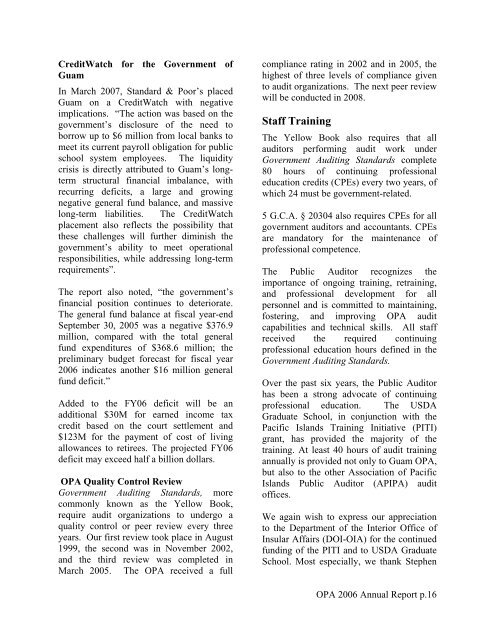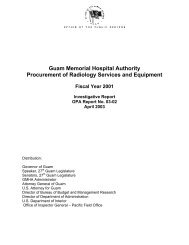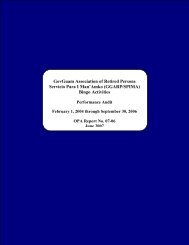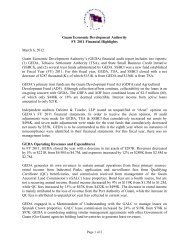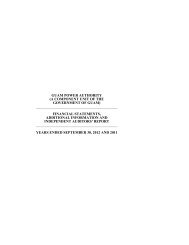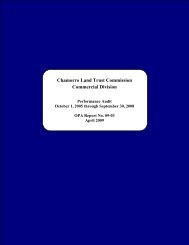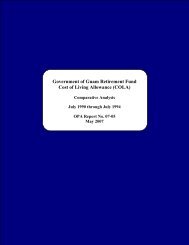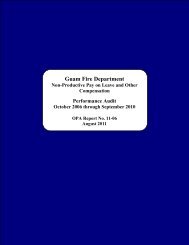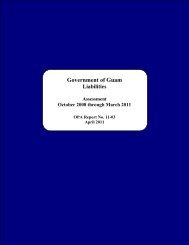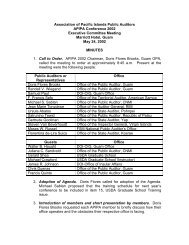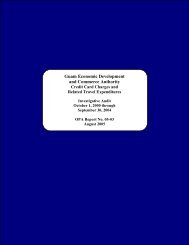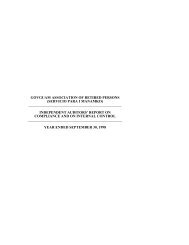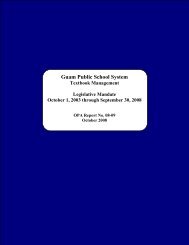2006 - The Office of Public Accountability
2006 - The Office of Public Accountability
2006 - The Office of Public Accountability
Create successful ePaper yourself
Turn your PDF publications into a flip-book with our unique Google optimized e-Paper software.
CreditWatch for the Government <strong>of</strong><br />
Guam<br />
In March 2007, Standard & Poor’s placed<br />
Guam on a CreditWatch with negative<br />
implications. “<strong>The</strong> action was based on the<br />
government’s disclosure <strong>of</strong> the need to<br />
borrow up to $6 million from local banks to<br />
meet its current payroll obligation for public<br />
school system employees. <strong>The</strong> liquidity<br />
crisis is directly attributed to Guam’s longterm<br />
structural financial imbalance, with<br />
recurring deficits, a large and growing<br />
negative general fund balance, and massive<br />
long-term liabilities. <strong>The</strong> CreditWatch<br />
placement also reflects the possibility that<br />
these challenges will further diminish the<br />
government’s ability to meet operational<br />
responsibilities, while addressing long-term<br />
requirements”.<br />
<strong>The</strong> report also noted, “the government’s<br />
financial position continues to deteriorate.<br />
<strong>The</strong> general fund balance at fiscal year-end<br />
September 30, 2005 was a negative $376.9<br />
million, compared with the total general<br />
fund expenditures <strong>of</strong> $368.6 million; the<br />
preliminary budget forecast for fiscal year<br />
<strong>2006</strong> indicates another $16 million general<br />
fund deficit.”<br />
Added to the FY06 deficit will be an<br />
additional $30M for earned income tax<br />
credit based on the court settlement and<br />
$123M for the payment <strong>of</strong> cost <strong>of</strong> living<br />
allowances to retirees. <strong>The</strong> projected FY06<br />
deficit may exceed half a billion dollars.<br />
OPA Quality Control Review<br />
Government Auditing Standards, more<br />
commonly known as the Yellow Book,<br />
require audit organizations to undergo a<br />
quality control or peer review every three<br />
years. Our first review took place in August<br />
1999, the second was in November 2002,<br />
and the third review was completed in<br />
March 2005. <strong>The</strong> OPA received a full<br />
compliance rating in 2002 and in 2005, the<br />
highest <strong>of</strong> three levels <strong>of</strong> compliance given<br />
to audit organizations. <strong>The</strong> next peer review<br />
will be conducted in 2008.<br />
Staff Training<br />
<strong>The</strong> Yellow Book also requires that all<br />
auditors performing audit work under<br />
Government Auditing Standards complete<br />
80 hours <strong>of</strong> continuing pr<strong>of</strong>essional<br />
education credits (CPEs) every two years, <strong>of</strong><br />
which 24 must be government-related.<br />
5 G.C.A. § 20304 also requires CPEs for all<br />
government auditors and accountants. CPEs<br />
are mandatory for the maintenance <strong>of</strong><br />
pr<strong>of</strong>essional competence.<br />
<strong>The</strong> <strong>Public</strong> Auditor recognizes the<br />
importance <strong>of</strong> ongoing training, retraining,<br />
and pr<strong>of</strong>essional development for all<br />
personnel and is committed to maintaining,<br />
fostering, and improving OPA audit<br />
capabilities and technical skills. All staff<br />
received the required continuing<br />
pr<strong>of</strong>essional education hours defined in the<br />
Government Auditing Standards.<br />
Over the past six years, the <strong>Public</strong> Auditor<br />
has been a strong advocate <strong>of</strong> continuing<br />
pr<strong>of</strong>essional education. <strong>The</strong> USDA<br />
Graduate School, in conjunction with the<br />
Pacific Islands Training Initiative (PITI)<br />
grant, has provided the majority <strong>of</strong> the<br />
training. At least 40 hours <strong>of</strong> audit training<br />
annually is provided not only to Guam OPA,<br />
but also to the other Association <strong>of</strong> Pacific<br />
Islands <strong>Public</strong> Auditor (APIPA) audit<br />
<strong>of</strong>fices.<br />
We again wish to express our appreciation<br />
to the Department <strong>of</strong> the Interior <strong>Office</strong> <strong>of</strong><br />
Insular Affairs (DOI-OIA) for the continued<br />
funding <strong>of</strong> the PITI and to USDA Graduate<br />
School. Most especially, we thank Stephen<br />
OPA <strong>2006</strong> Annual Report p.16


